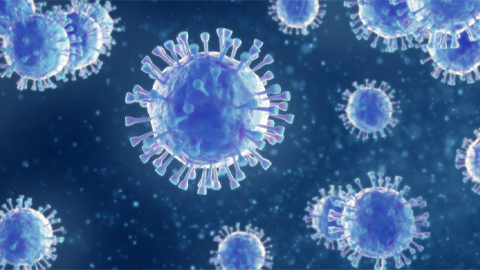From the journals: JBC
Variability in flu virus subtypes. How CBD works to treat neuropathic pain. Why COVID-19 makes some patients sicker than others. Read about papers on these topics recently published in the Journal of Biological Chemistry.
Variability in flu virus subtypes
The influenza virus mutates rapidly, so host immune systems must constantly adapt to new strains. The most variable, rapidly evolving part of the virus is influenza hemagglutinin, or HA, a surface glycoprotein containing a head domain (part of the HA1 subunit), a connecting stem region and a fusion peptide (part of the HA2 subunit) responsible for mediating binding and membrane fusion. However, scientists know little about the roles of different HA subtypes, such as H1 and H3, in the fusion pathway.

Natalie Garcia, Sally Kephart and colleagues at the University of Washington in Seattle have now described in an article in the Journal of Biological Chemistry their findings on subtype-specific activation and inhibition of HA. The authors used hydrogen-deuterium exchange mass spectrometry to compare the fusion activation of H1N1 and H3N2 influenza subtypes.
They found that at acidic pH conditions that promote membrane fusion, different regions of these HA peptides displayed increased dynamic changes; in H1, the HA1/HA2 interface was more dynamic, while in H3 the fusion peptide was most altered. They also showed that a broadly neutralizing antibody that targets the stem region of HA led to decreased conformational dynamics in the fusion peptide of H3 but had no effect on dynamics in the H1 fusion peptide.
These findings show that sequence variation in HA impacts how the protein responds to pH, suggesting that there may be multiple mechanisms by which influenza viruses prime for membrane fusion. The authors also conclude that the entire HA complex does not behave as a cohesive unit and that local conformational dynamics play a considerable role in functional variation.
How CBD works to treat neuropathic pain
Almost 1 in 10 people experience neuropathic pain, or NP, which can significantly affect their quality of life. Peripheral nerve injuries can sometimes trigger related changes in the spinal cord and dorsal root ganglion, leading to altered expression of neurotransmitters such as glutamate, glycine and GABA. Treatment options are limited, and some patients feel no pain relief after treatments. However, scientists have found several compensatory mechanisms to suppress pain via endogenous processes. These include modulating inflammatory cytokines and synaptic receptors or ion channels.
In a recent paper in the Journal of Biological Chemistry, Jing Xia, Dan Xiao and colleagues at the University of Science and Technology in Hefei, China investigated the role of a glycine receptor subunit GlyRα1 in NP and the potential effects of cannabinoids in treating the pain. Using mice in which nerves were cut and ligated to induce chronic pain, the authors observed that spinal GlyRα1 levels are increased in NP via a calcium-dependent mechanism. They also found that the synthetic cannabinoid DH-CBD interacted with a specific amino acid, serine 296 in GlyRα1, to block glycinergic neurotransmission and suppress neuronal hyperactivity.
This study shows that DH-CBD in part relieves pain by enhancing the function of the inhibitory neurotransmission of glycine receptors. Although further testing is needed, these findings present a potential mechanism behind the efficacy of using cannabinoids to treat NP.
Why COVID-19 makes some patients sicker than others
After contracting COVID-19, some patients experience severe or extended respiratory symptoms, while others recover after only a brief infection. Scientists do not yet understand why this selective severity is experienced by some, in particular the elderly or patients with comorbidities such as high cholesterol.
The SARS-CoV-2 virus enters mammalian cells by binding to the angiotensin-converting enzyme 2, or ACE2, but the more infectious omicron variant also enters cells via endocytosis. In their recent paper published in the Journal of Biological Chemistry, Hao Wang and colleagues at the Herbert Wertheim UF Scripps Institute for Biomedical Innovation & Technology describe how they investigated SARS-CoV-2 infectivity.
Using direct stochastic optical reconstruction microscopy, the researchers showed that ACE2 was localized into nanoclusters containing the signaling lipid PIP2. However, after the uptake of cholesterol into cell membranes, ACE2 moved from PIP2 lipid clusters to those containing endocytic ganglioside GM1 lipids. The team found that this movement of ACE2, as well as saturated lipids such as sphingomyelins, was an important contributor to SARS-CoV-2 entry into the endocytic pathway.
The researchers used these findings to propose a model for the role of cholesterol in age- and co-morbidity-dependent infection of SARS-CoV-2. Further research in this area could lead to new strategies to fight COVID-19, such as drugs that disrupt GM1 lipid nanoclusters in the plasma membrane and reduce viral uptake.
Enjoy reading ASBMB Today?
Become a member to receive the print edition four times a year and the digital edition monthly.
Learn moreGet the latest from ASBMB Today
Enter your email address, and we’ll send you a weekly email with recent articles, interviews and more.
Latest in Science
Science highlights or most popular articles

The science of staying strong
Muscles power every movement, but they also tell the story of aging itself. Scientists are uncovering how strength fades, why some species resist it and what lifestyle and molecular clues could help preserve muscle health for life.

Bacteriophage protein could make queso fresco safer
Researchers characterized the structure and function of PlyP100, a bacteriophage protein that shows promise as a food-safe antimicrobial for preventing Listeria monocytogenes growth in fresh cheeses.

Building the blueprint to block HIV
Wesley Sundquist will present his work on the HIV capsid and revolutionary drug, Lenacapavir, at the ASBMB Annual Meeting, March 7–10, in Maryland.

Gut microbes hijack cancer pathway in high-fat diets
Researchers at the Feinstein Institutes for Medical Research found that a high-fat diet increases ammonia-producing bacteria in the gut microbiome of mice, which in turn disrupts TGF-β signaling and promotes colorectal cancer.

Mapping fentanyl’s cellular footprint
Using a new imaging method, researchers at State University of New York at Buffalo traced fentanyl’s effects inside brain immune cells, revealing how the drug alters lipid droplets, pointing to new paths for addiction diagnostics.

Designing life’s building blocks with AI
Tanja Kortemme, a professor at the University of California, San Francisco, will discuss her research using computational biology to engineer proteins at the 2026 ASBMB Annual Meeting.

